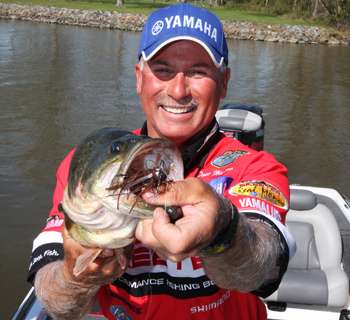
Matching the best line to your jigs has never been easier than it is today. Years ago, before all these new lines, all we had was monofilament, like Trilene XT. It was pliable enough to throw and sensitive enough to feel a bite. Jig fishing was an art back then. Today, though, anyone can be an excellent jig fisherman. I've always got one tied on.
Jigs can be used in most any application, any time of the year. When bass are eating crawfish — which is a lot of the year — they'll eat a jig. When they're eating shad, they'll eat a swimming jig. The one thing that stays the same regardless of the type of jig I'm throwing is that I'm using fluorocarbon — with one exception.
With fluorocarbon, you can use a much thinner diameter line, and it's a lot more sensitive than mono ever dreamed of being. Everyone loves those bites where the fish nearly pulls the rod out of your hands, but more often than not it's a really subtle touch. You lift up, feel a little weight or see the line just start moving off in one direction or the other. Fluorocarbon makes detecting these subtle bites much easier.
When jig fishing — be it a football jig, swim jig, flipping jig — I rarely go below 15-pound-test fluorocarbon. The only instance is when I'm throwing a Bass Pro Shops Stacey King Finesse Jig in really clear water, then I'll go to 12-pound test. The diameter of 15-pound-test fluorocarbon is really good for castability and is very strong. When I'm swimming a jig and line size diameter isn't an issue, I'll bump it up to 20-pound test. With some of my punch baits, I'll use 25-pound test.
When I won the Northern Open on the Upper Chesapeake last year, I was throwing a football jig with heavy fluorocarbon. I was dealing with rock and current, so I needed strong and sensitive line, and fluorocarbon offers both of these traits. I'll even use fluorocarbon where most wouldn't.
There are two instances where I like to use fluorocarbon when I'm flipping. The first case is if the grass isn't all that thick and if I want to slip a jig into a pocket or hole in the grass. The other case is where the fish are highly pressured. If everyone is flipping baits into thick grass, I feel that fluorocarbon gives me an advantage. For both of these scenarios, I use 25-pound test. When the cover gets really hairy, I use braid.
For all the great things about fluorocarbon, there is no substitute for the strength that braided line affords us as anglers. With heavy (50- to 60-pound) braid, you can toss big, heavy jigs into thick grass, set the hook on a big bass and rip it out of there. No other line lets you do that, plain and simple.
Since you can't talk jigs without mentioning trailers, I like scented trailers like NetBait's Baby Paca and Paca Chunk. They hold up really well and fish tend to hold on to the jig a bit longer. If I'm using something else, like a Zoom Speed Craw, I dip it in clear J.J.'s Magic Dippin' Dye. It has a powerful garlic scent.





